 |
|
Here and There introduces art, artists, galleries, museums, and other cultural facilities around Japan that non-Japanese readers and first-time visitors may find of particular interest.
|
|
 |
|
|
 |
 |
Don't Wait to Exhale: Artists' Breath at the Ichihara Lakeside Museum
Alan Gleason |
 |
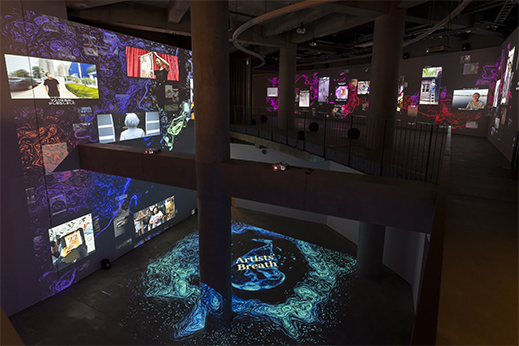 |
|
Fram Kitagawa is the impresario behind Japan's profusion of regional art festivals, which seem to proliferate year by year. When the coronavirus pandemic forced the postponement of several such events scheduled for 2020, Kitagawa contacted participating artists around the world and asked them to join in an Instagram project and submit two-minute videos documenting their thoughts and experiences in these fraught times. Titled Artists' Breath, the project drew contributions from 194 artists in 34 countries. Though on hiatus since January, Artists' Breath is currently enjoying reincarnation as a visually stunning exhibition at the Ichihara Lakeside Museum in rural Chiba Prefecture.
Situated on the shore of Lake Takataki amid the rolling hills of the Boso Peninsula, which forms the east side of Tokyo Bay, the museum was supposed to serve last summer as the hub of Ichihara Art x Mix, a Kitagawa-directed festival that showcases the scenic Yoro River valley and the charmingly retro Kominato Railway that runs along it. The event was postponed to this year but has yet to open due to the ongoing state of emergency, still in effect at this writing. Meanwhile, the museum, whose planning is handled by Kitagawa's Art Front Gallery in Tokyo, is helping to take up the slack with Artists' Breath, for which it proves to be the ideal venue. (For the time being, at least, the museum is happily outside the purview of the emergency declaration.) For a more detailed look at the Ichihara Lakeside Museum and its environs, see the October 2020 edition of this column.
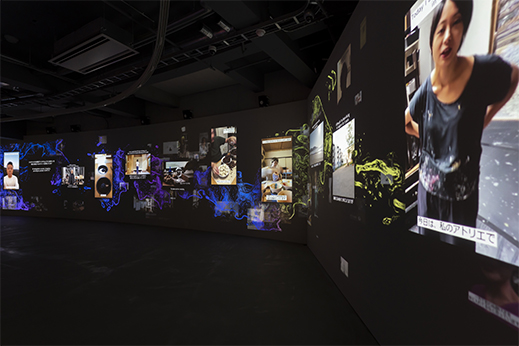 |
|
There's no dearth of multimedia installations nowadays that confront the visitor with phalanxes of video screens. However worthwhile each work may be, the eyes tend to glaze over at the prospect of watching every one of them from start to finish. Nor do the visuals of such shows offer much to write home about when the exhibit space is just a room full of monitors. The Artists' Breath installation avoids these pitfalls, and does so in style.
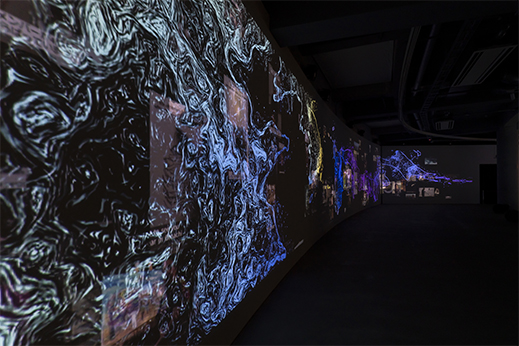 |
|
Entering the first gallery reminded me of those amusement park rides that take you into what seems to be a pitch-dark cavern until your eyes adjust. Here, the darkness immediately gives way to a long wall across which shimmering, slithering colors play, stretching into the distance and forming the backdrop to a row of video projections. The space is filled with the murmur of concurrent soundtracks, none loud enough to drown out the others, but by the same token barely audible should you want to zero in on one of them. Fortunately every video has subtitles in English as well as Japanese. Since they all clock in at around two minutes, it is perfectly feasible to watch them from start to finish -- but there are so darn many!
 |
|
And yet, the effect is nowhere near as brain-numbing as it might sound. That is because the presentation in toto is a work of art in itself, and visitors will find it sufficiently gratifying to take in the entire spectacle as it unfolds, with the eye flitting randomly from one video to another. What holds everything together is the light show in the background, which gradually reveals itself as a series of shape-shifting maps of different parts of the world: East Asia, Europe, Africa, the Americas, Australia, the Japanese archipelago. Unlike any maps you ever saw, though, these are composed of writhing blobs of color that conjure up waves, rapids, whirlpools.
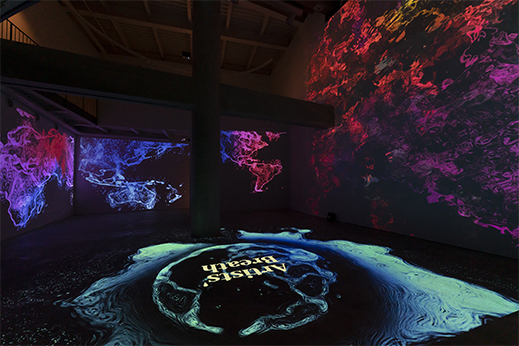 |
|
Credit for this psychedelic wonderland goes to video artist Keisuke Takahashi, whose installations have graced a number of Kitagawa's art festivals. By making maps the background to the videos and generating them from roiling wave patterns and mutating hues, Takahashi brings thematic unity and visual excitement to what would otherwise be just another lineup of videos on a wall. The continents that come and go not only tell us where the videos on view at any given moment originated, they immerse those images in a single all-encompassing one: the "sea of life" that, in the director's words, connects these artists -- and all humanity -- together.
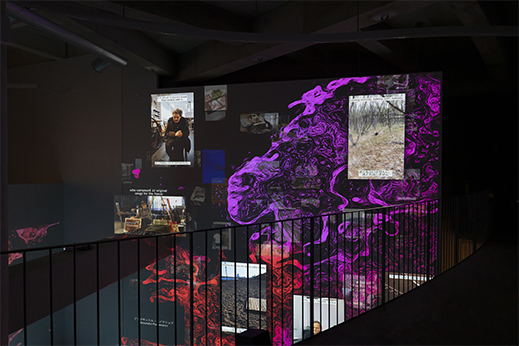 |
|
Takahashi's magic also plays off the museum's unique design. The first gallery forms a long arc around one side of an atrium-like space that rises from the floor downstairs. From the upper-floor balcony one can look down and across to an even more dramatic display, two stories high, on which more videos are projected. Here, too, the continents ebb and flow. Descending the stairs for a closer look at the big wall, one finds that the floor, too, is part of the planet: at its center sits Antarctica, emblazoned with the "Artists' Breath" logo. Check out this video for a better idea of the sheer dynamism of the installation.
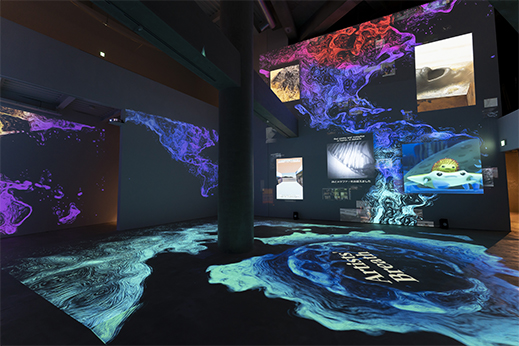 |
|
As for the videos themselves, they are as diverse as 194 artists can be. Their responses to Kitagawa's simple request to share "how they are living and what they are thinking" yielded a fair number of stoic talking-head monologues about how the pandemic has impacted the artist, or show-and-tells about current projects. Far more enjoyable were works that indulged in a bit of creative play with the video medium itself.
Among my favorites were the videos by Russia-born, Croatia-based Ekaterina Muromtseva, whose Balcony Gallery paintings depict "philosophers and the flies who disturbed them while they were thinking"; Japanese artist Ei Wada and his friends, who jam on old TV sets electronically converted into percussion instruments; Mexican artist Gerardo Vargas, who offers a joyous speeded-up clip of a day indoors with his son, making toys as well as art; Paris-based Algerian Adel Abessemed, who conveys his message on a stack of cards in homage to Bob Dylan's immortal short "Subterranean Homesick Blues"; Japan's Eat and Art Taro, who spends his two minutes shucking lychees and chatting about food; and Taiwan artist Yu Wen-Fu, who periodically interrupts a hilarious but heartwarming message to friends in Japan with honks on an accordion. Oh, and then there's German choreographer Thomas Lehmen, who presents a wacky corona-themed dance (everyone falls down at the end) by the "First Unemployed Ballet in Oberhausen."
 |
|
The place to view all these pieces in their entirety -- or as many as you feel like, anyway -- is the project's Instagram page, which remains accessible and will stay up after the Ichihara exhibition closes on 27 June. But readers in the greater Tokyo area would do well to make the trek out to Boso and experience the museum installation firsthand. An added bonus is a side gallery featuring a related Kitagawa project: a display of masks associated with seasonal festivals throughout Japan. The theme is the 24 sekki or mini-seasons of the old Japanese calendar, which divides the year into two-week segments, most of them named after events or weather conditions relevant to the farming cycle. Early June is the time of Boshu, or Grain Planting, followed by Geshi, the Summer Solstice, and Taisho, the Big Heat. The masks are a reminder, Kitagawa says, that even in the time of corona, life goes on and seasons change. The director himself poses in a number of them to excellent comedic effect in this clip.
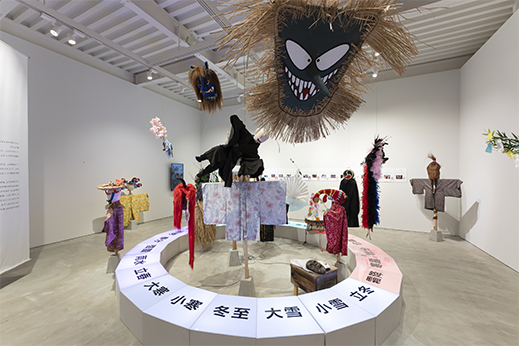 |
|
One hopes that before the summer is out, visitors to central Boso will also be able to enjoy the long-delayed Ichihara Art x Mix festival. The Yoro Valley is a relatively unknown gem of a place despite its proximity to Tokyo. Boasting deep gorges, waterfalls, hot springs, and the geologic site (a riverside cliff) that gave its name to the Chibanian Age, Yoro's natural wonders are complemented during the festival by a host of outdoor installations that pop up in the most unlikely spots. For updates on the status of Ichihara Art x Mix, check here.
All photos by Yuichiro Tamura, courtesy of the Ichihara Lakeside Museum. |
 |
| Artists' Breath: Artists in the Midst of the Pandemic (in Japanese only) |
| 3 April - 27 June 2021 |
| Ichihara Lakeside Museum |
75-1 Funyu, Ichihara, Chiba
Phone: 0436-98-1525
Hours: 10 a.m. to 5 p.m. Tuesday - Friday; 9:30 a.m. to 7 p.m. Saturday and days before holidays; 9:30 a.m. to 6 p.m. Sunday and holidays; closed Mondays and year-end holidays. (When Monday is a national holiday the museum is closed on the following day instead.)
Access: By train: 20 minutes' walk or 5 minutes by taxi from Takataki Station, on the Kominato Railway 40 minutes from Goi Station on the JR Uchibo Line, accessible from Tokyo Station via the JR Keiyo Line (total travel time from downtown Tokyo, about 2 hours). By bus: 5 minutes by taxi from Ichihara Tsurumai Bus Terminus, about an hour by expressway bus from Tokyo Station.
|
|
|
|
| |
 |
Alan Gleason
Alan Gleason is a translator, editor and writer based in Tokyo, where he has lived for over 30 years. Since 2006 he has edited artscape Japan and written the Here and There column, as well as translating the Picks reviews. He also edits and translates works on Japanese architecture, music, and theater. |
|
|
|
|
|
|
|
|
|
 |
|